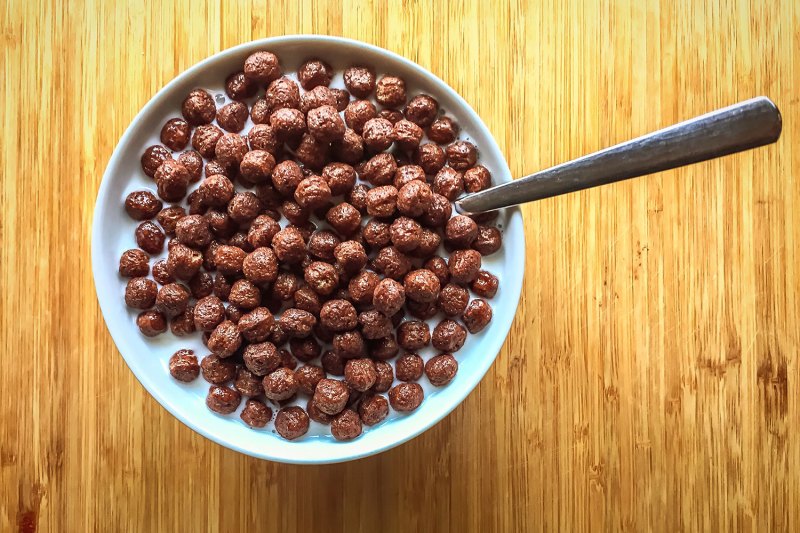
Mmm, the cereal aisle. The very reason we went to the grocery store — turning the corner and gazing up at the colorful rows of boxes, knowing one would be ours. That was followed by waking up Saturday morning, pouring a heaping bowl, and basking in the glow of sweet, sugary glory.
If you don’t feel this nostalgic joy about childhood cereals you probably ate oatmeal as a nine-year-old and liked it (bleh). But whether you missed out on the delicious, transcendental experience of kids cereal or want to relive it, here are the 10 best childhood cereals to relive your glory days, all of which you can still find today (RIP Reptar Crunch).
Lucky Charms

Released by General Mills in the 60s, Lucky Charms is a grade-A childhood cereal that we can’t believe our parents let us eat. Other than being pure sugar, Lucky Charms has vitamins and minerals like folic acid, iron, and B-12 according to Livestrong (sure, we can pretend). The experience of eating this cereal is all about the thrill of the hunt, weaving your spoon through a sea of frosted oats to nab horseshoes, rainbows, and moons. And that post-cereal milk… bartender, pour me a double.
French Toast Crunch

Don’t get me wrong, we’re major fans of Cinnamon Toast Crunch, but there’s something next-level about its elusive step-brother French Toast Crunch, which General Mills brought back in 2014 after being begged by consumers online. @Darth_DURFFFY tweeted, “Nothing could fill the hole in my heart where French Toast Crunch used to be,” when the mini French toast breakfast cereal was discontinued in 2006. First launched in ‘95, “bursting with cinnamon and syrup taste,” it’s good to have you home, little toasts.
Fruity Pebbles

Nobody questioned why The Flintstones’ Fred and Barney were the spokesmen for rice puff cereal Fruity Pebbles (there are some questions you just don’t ask), but you recognized the box by their Neanderthal mugs all the way from the check out. Released by Post Foods in 1971 with twin Cocoa Pebbles, there’s a bizarre phenomenon where Fruity Pebbles tastes different to each person. It’s fruity in that faux fruit way, but some say the cereal tastes like Earl Grey, others say cardboard (heinous), but we think it’s 90s nostalgic heaven.
Rice Krispies Treats

Marketed as “wholesome crispy clusters,” the Treats edition of Rice Krispies cereal was glorified Rice Krispies bars pulled apart and called cereal. Yes, it was light years better than the standard Rice Krispies cereal because the tiny rice puffs all alone got soggy within seconds. But the Treats? Good crunch, marshmallow-y sweetness. Ten out of ten would snap, crackle, and pop again.
Cocoa Puffs

This dog-food looking chocolate cereal produced by General Mills did make us cuckoo. We were so small and eating little globes of chocolate, corn, oats, rice, and all kinds of corn syrup. The sugar crash hangover was so worth it. Cocoa Puffs are basically chocolate-flavored Kix while Trix is fruit-flavored Kix, and it’s a hard toss between Cocoa Puffs, Count Chocula, Cocoa Pebbles, and Cocoa Krispies.
Honeycomb

Did our eyes pop out of our heads eating Honeycomb cereal? Was there a hairy gremlin monster than hung around the box? You only know if you ate the honey-flavored corn cereal — particularly in its 90s (or 80s or 70s) iteration. Some cereal conspiracy theorists doubt that today’s Honeycomb is the same recipe. You be the judge: Throw on your Bugs Bunny t-shirt and Starter jacket and pour a bowl.
Cookie Crisp

Some genius in the 70s said ‘chocolate chip cookies and milk are amazing, what about a bowl of cookies in milk … for children … to eat at breakfast.’ And they were promoted. Eating Cookie Crisps as a kid was like robbing a bank and getting away with it. You had beat the system, tricked your parents, and couldn’t be stopped. Originally made by Ralston, they sold Cookie Crisp to General Mills and the recipe changed in ’97. It’s still cookies, so calm down.
Frosted Flakes

All the athletes on the Frosted Flakes boxes did convince our childhood selves we were eating a super-human food. Plus, the sugar-coated corn flakes tasted grrreat. There really was something lean and mean about this cerulean blue box and flexing Tony the Tiger, and you probably ate these before baseball on the weekends (and hit dingers like Big Al). Today, Kellogg’s has taken Frosted Flakes to new highs, creating a seasonal pumpkin spice flavor and hybrid Lucky Charms Frosted Flakes … which is pure madness.
Cap’n Crunch

Quaker Oats Company tried recreating a recipe of brown sugar and butter over rice and ended up with the oat and corn cereal Cap’n Crunch. The slight peanut-butter taste was the origin of our adult nut butter obsession, and the Cap’n himself, Horatio Magellan Crunch, will remain one of the most iconic cereal mascots of all time. And get this, he’s not even a real captain! Technically this childhood cereal should have been called Commander Crunch.
Oreo O’s

The short-lived high of Post Cereals and Kraft Foods lovechild Oreo O’s lasted only a decade between 1997 and 2007. Boy was that a time to be alive. Oreos for breakfast! And parents genuinely thought it was a healthy option. Kraft owned the name and Post owned the recipe, but the two couldn’t get along so they discontinued the O-shaped cookie cereal. Post restarted production another decade later in 2017 with a new real crème filling recipe. It won’t taste exactly the same, but you were like seven so you wouldn’t remember anyway.


